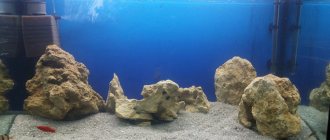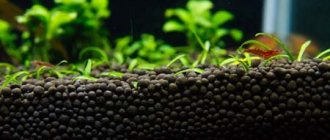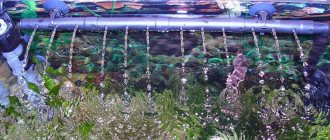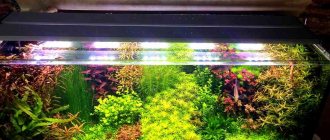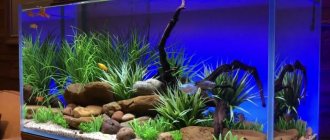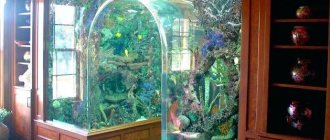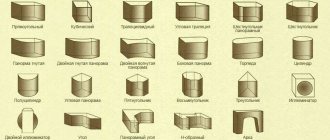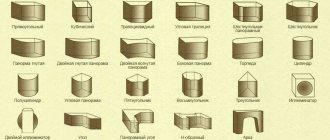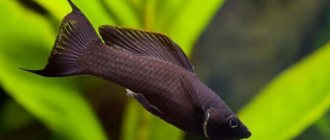Basic characteristics of aquarium soil
Before we consider which soil to choose for an aquarium, we need to evaluate what types of soils exist and where they can be obtained.
Roughly, soils can be divided into the following groups:
- natural soils – pebbles, natural sand, gravel and crushed stone;
- soils resulting from the processing of natural soils by chemical or mechanical means;
- artificially created soils.
Sandy soil is one in which particles are smaller than a millimeter. River sand is quite popular among aquarists, however, you need to know that it lies on the bottom very tightly and water does not pass through it. Such soil is susceptible to rotting, which means that during this process methane, hydrogen sulfide and ammonia are released - gases that are very harmful to fish and plants.
River sand as a soil has one drawback - it lies too tightly on the bottom.
If the soil particles exceed 5 millimeters in size, then they are pebbles. The situation with pebble soil is mirrored in relation to sandy soil. Everything penetrates through the pebble soil - water, food, and waste products. The food that has fallen to the bottom falls through the pebbles and the fish cannot get it, especially small ones - they simply do not have enough strength to do so. Accordingly, there is greater consumption of food and more pollution of the aquarium. And this leads to the fact that you have to clean the aquarium more often.
Experience shows that the best soil chosen for an aquarium is one with rounded round grains, the diameter of which is less than 5 millimeters.
Aquarium pebble size
Aquarium pebbles
An important indicator of aquarium pebbles is their size. All aquarium stones whose size does not exceed 1 mm can be classified as sand. Its use is impractical due to its high density and impermeability. With poor aeration, it quickly cakes, becomes saturated with excrement, bacteria, and the processes of rotting and the formation of hydrogen sulfide begin in it. If the aquarium contains fish that like to play with gravel, then contact with such sand will not be beneficial for them. In addition, if fish pick up food from the ground, they can swallow sand particles and die.
The other extreme is aquarium stones larger than 5 mm. This is the opposite situation with sand. This soil is too coarse, permeable not only to water, but also to feed. Particles of food may fall under a layer of stones, and fish will not be able to reach it. This leads: firstly, to greater consumption of food, and secondly, to rotting of food residues at the bottom of the aquarium. In this situation, even a bottom filter cannot help. Therefore, such soil is also not suitable for a home pond.
For many, there is a temptation to use shell rock or marble chips as a bottom covering. However, this is also not the best option; these stones contain calcium carbonates. In the soft and acidic environment of the aquarium, they begin to dissolve, resulting in increased water hardness. The same effect is produced by natural shells placed in an aquarium for beauty.
Therefore, aquarists consider rounded gravel with round grains up to 5 mm in diameter, neutral color and natural origin to be the best soil for an aquarium. You can collect such bottom covering on the bank of the nearest river.
Using river soil is a good alternative to not buying something similar in the store. With some effort, you can choose almost every pebble at your discretion, taking into account size, color, and shape. Considering that this soil will probably serve the owners for many years, it is worth spending some time on this. Very small sea pebbles can also be a good bottom covering; you can collect them on the nearest beach.
What soil to choose for an aquarium
You can collect such soil in ravines or on river slopes. Larger sand particles, under the influence of gravity and wind, roll down and that’s where you need to look for them. One of the main conditions is that it should not contain ingredients soluble in water. And it is very important - shell rock, marble and so-called coral sand should absolutely not be used as soil.
See also: Full review of Kupper boilers: technical characteristics, model range, advantages and disadvantages
The beauty of such soil - and it really looks beautiful in an aquarium - will be a boon to the fish living in it. All these substances contain calcium carbonate. In water, soft or acidic, carbonates begin to dissolve, making the water in the aquarium hard.
Checking for the presence of calcium carbonate in the soil is as easy as shelling pears - just splash vinegar on it. If foam and bubbles appear on the surface of the soil, this is a sign that such soil is not suitable for improving the aquarium. True, it must be said that some aquarium fish are quite indifferent to hard water. These, for example, include Malawian cichlids, which live in hard water in natural conditions and do not care about these little things.
What type of soil is this?
Rocks (usually sandstone, granite, marble or gypsum) erode over time, and their fragments are washed by water. Such pieces of rock washed to varying degrees are pebbles. The diameter of the fragments can be from 1 millimeter to 15 centimeters (from 2 to 6 mm are suitable for an aquarium). Most often, such filler is beautiful and multi-colored, which looks especially beneficial if the fish and plants are not bright enough.
Placing soil in the aquarium
The soil in the aquarium is placed not just like that, but wisely. However, in the aquarium business there are no trifles at all, since we are talking about living organisms. Before laying the soil, it is necessary to resolve some issues on which the effectiveness of its use depends. You need to understand what layer to pour it in, at what angle or horizontally, whether to make terraces or not, what to do to prevent the soil from crumbling.
Considering that we have already chosen the correct size of the soil, we will figure out the thickness of the coating. So, the soil should “breathe” freely, which means that the layer should not be thick. For fine, sandy gravel (in case you have no choice), the layer thickness should not exceed two centimeters. This is not much and large plants will not be able to gain a foothold in such soil.
Fine gravel, the particle size of which reaches four millimeters, the thickness of the soil will be greater - up to 5 centimeters. Most aquarium plants will “sit” on such soil. Soil, the particles of which reach sizes from four to five millimeters, can easily be made up to seven centimeters thick. If we are talking about planting plants, then we choose such a soil - it will withstand anything.
Coarse soil can be safely laid in a layer of up to 7 centimeters.
Soils can be poured horizontally and at different angles. Practice shows that soil poured at an angle has some advantages over soil poured horizontally. With this soil configuration, all the debris (or most of it), dirt and other ingredients simply roll downhill and accumulate at the bottom.
See also: The best remedy for mice in the house
It is convenient to remove it. This time. The soil raised to the wall improves the visibility of the contents of the aquarium - fish and plants. That's two. Third, the soil located at different levels allows you to plant the “underwater garden” more effectively and correctly. In the thicker part of the soil - in the background, more powerful plants are planted, in "shallow water" - accordingly, smaller plants. However, the architectural activity associated with pouring sand at an angle is interfered with by the force of gravity and the flowability of sand and gravel.
Over time, these factors reduce the entire difference in levels to the horizontal, and everything has to start all over again. To prevent this from happening, the soil is fixed, for example, with large flat stones. You need to find pebbles of the appropriate size and dig them in as closely as possible to each other. These are limited to a higher area.
Many people like to have terraces in their aquarium. To create them, you can use, for example, plexiglass. This is done quite simply. We take a strip of plexiglass and place it so that it fences off the corner of the aquarium. We fill this area with soil - the triangular terrace is ready. To get a wavy terrace you will need to work a little. A strip of plexiglass is heated in the right places and bent at the right angle. The main thing here is not to overheat, the plexiglass can catch fire. After the plexiglass has cooled, it is placed in the required location.
Varieties
There are two main types of pebbles for aquariums:
- marine;
- river
A short video on the topic:
Marine
The predominant color is white (and other light colors), this stone is flatter and has a smoother surface than other types. Before placing it in the aquarium, it is recommended to rinse it well to remove salt deposits.
River
It is distinguished by a much greater variety of colors and a more convex shape, and sometimes larger sizes compared to the sea one. The surface is more rough. Also needs to be washed before use.
Soil preparation
Knowing how to choose soil for an aquarium, we must understand that throwing freshly collected soil into an aquarium is like eating pies with dirty hands. The soil must be properly prepared so that it does not contain any unnecessary or harmful elements. Substances such as pyrite or, for example, magnetite, can reduce all living creatures in the aquarium to zero. It is best if the soil contains feldspar or quartz. These are neutral minerals and will not kill anyone in an aquarium.
Before adding soil to the aquarium, rinse it thoroughly.
To ensure that you get rid of calcium that may be contained in the soil, you need to dissolve it. Acid is used for this purpose. Experts say that hydrochloric acid copes best with this task. The soil is poured into a glass or plastic container that is not affected by acid, and filled with hydrochloric acid. The acid is kept in the soil for 2-3 hours and after that it is thoroughly washed with running water for at least 30 minutes.
See also: Simple tips: how to choose curtains for the bedroom
It is necessary to immediately warn anyone who will get rid of calcium in this way that hydrochloric acid is one of the most powerful in nature, and it can cause real harm to health. You can work with it only with rubber gloves and preferably with glasses.
If the aquarium owner cannot find acid, the soil must be washed. The method is simple. The soil is poured into a bucket, the bucket is placed on the ground or, if this happens in an apartment, in a basin, so as not to clog the sewer. The soil is washed with water and mixed at the same time. Clay and dirt should be removed. The more carefully this operation is done, the faster the water in the aquarium will become transparent.
Some aquarists boil the soil and believe that there is nothing reprehensible in this, while others believe that this is unacceptable. It is believed that boiling kills microorganisms that keep water bodies clean, and the plants will have nothing to eat. However, many boil the soil and everything is fine with them. Substances that serve as plant nutrition are simply mixed into the soil.
Soil: artificial or natural
Soil for an aquarium
For fish lovers, there is now no shortage of decorative soils, which are sold in specialized stores of different sizes and colors; they can satisfy the most demanding taste. However, many people prefer to use natural soil - stones and coarse sand are collected from river and sea beaches, rocky slopes, even just from the nearest sandbox. However, in order to create not only a beautiful, but also a healthy environment in your aquarium, it is important to know a few rules.
Since the soil is divided into natural and artificial, it is better to make a choice in favor of natural for a number of reasons:
- Artificial soil most often has too bright a color, so it is impossible to create natural lighting for such an environment in an aquarium; even shades of white are not able to balance the light. White generally loses its color over time under the influence of microorganisms, medications for inhabitants, and fish waste.
- Improper organization of lighting can negatively affect the proliferation of beneficial bacteria that create favorable microflora. Black pebbles, popular with many, inhibit the growth of necessary microorganisms and make the water dead.
- Unnatural soil is not capable of sufficient aeration and inevitably leads to cloudiness of the water in the aquarium.
- Artificial color also creates an unnecessary background that distracts from contemplating the natural beauty of the fish.
- The most common material for artificial colored soils is glass. Therefore, when planting plants in such pebbles, it will be necessary to provide them with powerful additional nutrition, because Such pebbles do not contain nutrients.
- Natural stones include: sea pebbles, coarse quartz sand, crushed rocks and minerals such as granite, quartzite, jasper, serpentine, basalt, feldspar, small pebbles and others. According to experienced aquarists, they are the ones who are able to provide a favorable environment for the normal life of fish.
- Natural stone is porous in structure and is capable of accumulating nutrients for grass and at the same time adsorbing some of the waste of fish.
- To feed plants, you can place nutrient tablets or special substrates under aquarium stones. Considering that natural stone is porous and capable of being saturated with useful substances, the use of ordinary pebbles is completely justified here. This reduces the consumption of tablets, reduces the turbidity of the water and generally simplifies the care of the aquarium.
Aquarium soil care
The soil must be looked after, otherwise a large amount of harmful products will accumulate in it, which gradually begin to poison the inhabitants of the aquarium. The cleaning process is quite labor-intensive. The soil is stirred up with a stick and the water with the rising suspension is sucked off with a specially prepared hose. This work must be done very carefully so that the roots of the plants remain intact and the fish are not harmed.
It will not be possible to clean all the soil and there is nothing wrong with that; on the contrary, the remains of organic matter are necessary to maintain plant life. They work like fertilizers. There are no ideally clean aquariums; nothing lives in them. Cleaning is done once every two months.
The question of which soil is best to choose for an aquarium is quite difficult and here it is necessary to consult with more experienced colleagues in the hobby. It never hurts.
Did the article help you?
Andrey
Ask questions
Ask questions and write answers in the comments
